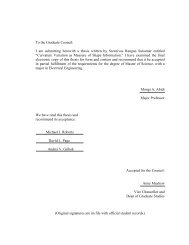To the Graduate Council: I am submitting herewith a dissertation ...
To the Graduate Council: I am submitting herewith a dissertation ...
To the Graduate Council: I am submitting herewith a dissertation ...
- No tags were found...
Create successful ePaper yourself
Turn your PDF publications into a flip-book with our unique Google optimized e-Paper software.
Chapter 3: A Feature Saliency Descriptor for Registration and Pose Recovery 32The function δ (P)depends on <strong>the</strong> eigenvalues of S (P)and employs <strong>the</strong>Surfappropriate thresholds to determine points that belong to two types of salientstructures: surfaces and curves as explained in [Medioni00]. Fig. 3.6 shows <strong>the</strong> 3Dreconstruction for different pose par<strong>am</strong>eters, starting at <strong>the</strong> correct par<strong>am</strong>eters at <strong>the</strong>left and gradually changing one of <strong>the</strong> rotation par<strong>am</strong>eters. In <strong>the</strong> lower sequence areshown <strong>the</strong> resulting salient points after <strong>the</strong> tensor voting and feature inference process.Isolated points were removed. The actual variation ofin Table 3.7. We see thatemployed in a pose recovery fr<strong>am</strong>ework.NSfor this sequence is shownN Scan be used as a point-set saliency measure andThis criterion is not expressed analytically in terms of <strong>the</strong> datasets and <strong>the</strong>transformation par<strong>am</strong>eters and optimization will have to be heuristic. But <strong>the</strong> notion ofevaluating <strong>the</strong> saliency of a set of points was <strong>the</strong> important idea that will be exploitedfor our core problem of general point-sets registration. In <strong>the</strong> next section we will shiftour focus and present our derivation of an analytically expressed saliency criterion for<strong>the</strong> purpose of point-sets and free-form shape registration. While <strong>the</strong> main emphasiswas first on <strong>the</strong> global saliency measure of a set of points, <strong>the</strong> local descriptor turnedout to be more useful in and of its self.3.3 The Local Saliency DescriptorOur purpose at this point is to design a simple local feature descriptor which will bebased on <strong>the</strong> principles of tensor voting. Being based on a robust feature inferencefr<strong>am</strong>ework <strong>the</strong> new descriptor is expected to have a good performance in <strong>the</strong> presenceof noise and in <strong>the</strong> case of sparse and non-uniformly s<strong>am</strong>pled datasets. Thisperformance will be confirmed later in through experimental analysis. In this work weare mainly interested in <strong>the</strong> basic case of non-oriented clouds of points. <strong>To</strong> derive <strong>the</strong>expression of our descriptor we employ <strong>the</strong> first pass of Tensor Voting.
















